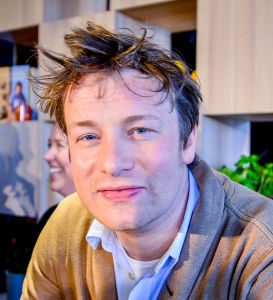I take what I see work. I’m a strict believer in the scientific principle of believing nothing, only taking the best evidence available at the present time, interpreting it as best you can, and leaving your mind open to the fact that new evidence will appear tomorrow. ~ Adam Osborne

“Jamie Oliver” by Karl Grober. CC-BY.
In 2010 celebrity chef Jamie Oliver won the Technology Entertainment Design (TED) Prize for his “One Wish to Change the World.” In addition to a monetary award, he was given 18 minutes at the prestigious TED Conference in Long Beach, CA to discuss his wish: “Teach every child about food.”[1] This chef from Essex, England, had only a short window of time to convince an American audience to change their most basic eating habits. To get them to listen he had to catch their attention and demonstrate his credibility. He managed to do both using compelling research. He began by saying, “Sadly, in the next 18 minutes . . . four Americans that are alive will be dead from the food that they eat.”[2] He magnified the problem with a chart showing that many more Americans die from diet related diseases each year than die from other diseases, or even from accidents and murder. Along with the statistics, he offered testimony from people living in the “most unhealthy state in America.”[3] By weaving together multiple forms of research over the course of his brief talk, Oliver crafted a compelling case for a massive shift in the way that Americans teach their children about food.
Like Oliver, in order to give an effective speech, you will need to offer support for the ideas you present. Finding support necessitates research. Librarians have found that professors and students tend to have very different ideas regarding what it means to conduct research.[4] Professors, who regularly conduct scholarly research as part of their occupation, tend to envision a process filled with late nights in the stacks of a library.[5] Students, who regularly conduct research on where to eat or what to do as part of their weekend activities, tend to envision a less formal process that involves consulting the most popular web search results. The reality is that in order to properly support your ideas and craft a compelling speech, you will need a little of each approach, possibly combined with investigative tools with which you may be less-familiar. The wide variety of resources available for conducting research can be overwhelming. However, if you have a clear topic, recognize the purpose of your speech, and understand the audience you will be speaking to, you can limit the number of sources you will need to consult by focusing on the most relevant information.

“Girder Gridwork” by skycaptaintwo. CC-BY.
Once you know the topic of the speech, you can create the specific purpose statement. This is a one sentence summary of the goal of your speech, that may begin with the phrase, “At the end of my speech, the audience will be able to…” This statement guides your research as you piece together the supporting evidence to fill out the remainder of your speech. As you work through the types of support in this chapter, continually ask yourself, “Does this evidence support the goal of my speech?” If the source offers information that contradicts your specific purpose statement, hold on to it so that you can address the contradiction with evidence for your own idea. If it does appear to support your specific purpose statement, the next question you will ask is “Is this evidence appropriate for my audience?” Different types of appeals and evidence are better for different audiences. The best speeches will combine multiple forms of evidence to make the most convincing case possible. This chapter will help you research your speech by combining personal and professional knowledge, library resources, and Internet searches. It will help you to evaluate the sources you find and cite them to avoid plagiarism.
Candela Citations
- Chapter 7 Introduction. Authored by: Sarah Stone Watt, Ph.D.. Provided by: Pepperdine University, Malibu, CA. Located at: http://publicspeakingproject.org/psvirtualtext.html. Project: Public Speaking Project. License: CC BY-NC-ND: Attribution-NonCommercial-NoDerivatives
- Jamie Oliver cropped. Authored by: Karl Gabor. Located at: http://en.wikipedia.org/wiki/Jamie_Oliver#mediaviewer/File:Jamie_Oliver_(cropped).jpg. License: CC BY: Attribution
- Girder Gridwork. Authored by: skycaptaintwo. Located at: https://www.flickr.com/photos/skycaptaintwo/44554073/. License: CC BY: Attribution
- Oliver, J. (2010, February). Jamie Oliver’s TED Prize wish: Teach every child about food. TED Ideas Worth Spreading. Speech retrieved from: http://www.ted.com/talks/jamie_oliver ↵
- Oliver 2010 ↵
- Oliver 2010 ↵
- Sjoberg, L.M. & Ahlfeldt, S.L. (2010). Bridging the gap: Integrating information literacy into communication courses. Communication Teacher, 24(3), pp. 131–135. ↵
- Leckie, G.J. (1996). Desperately seeking citations: Uncovering faculty assumptions about the undergraduate research process. The Journal of Academic Librarianship, 22(3), p. 201–208. ↵